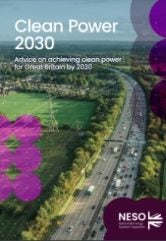
A new report by the UK’s National Energy System Operator (NESO), Clean Power 2030 – Advice on achieving clean power for Great Britian by 2030, sees a role for nuclear with life extensions for the current fleet and new nuclear plants. The 84-page report was commissioned in August by Secretary of State for Energy Security & Net Zero, Ed Miliband. Government will consider the advice in this report in developing its clean power action plan later this year.
The report has three key messages:
- Clean power is a huge challenge but is achievable by 2030 while maintaining security of supply. Several elements must deliver at the limit of what is feasible. A key challenge will be making sure all deliver simultaneously, in full and at maximum pace, in a way that does not overheat supply chains and is sustainable.
- Clean power will require doing things differently and will require bold action and sustained momentum. This requires: contracting “as much offshore wind capacity in the coming one to two years as in the last six combined”; delivering “first-of-a-kind clean dispatchable technologies, such as carbon capture and storage and hydrogen to power”; building all planned transmission network on time; reforming connection processes in 2025 to align with the clean power goal and future strategic plans; reforming planning and consenting processes; reforming electricity markets while ensuring a stable and attractive investment environment, to secure over £40bn ($51.5bn) of investment annually to 2030; and consolidating digitalisation initiatives into a sector-wide prioritised plan, with expedited data sharing and enhanced decision-making driven through rapid adoption of artificial intelligence.
- Achieving clean power by 2030 will put Great Britain in a strong position.
The report says: “Our clean power pathways see a four-to-fivefold increase in demand flexibility (excluding storage heaters), an increase in grid connected battery storage from 5 GW to over 22 GW, more pumped storage and major expansions in onshore wind (from 14 GW to 27 GW) and solar (from 15 GW to 47 GW) along with nuclear plant life extensions.
Clean power sources include “renewables (including biomass) and other low carbon sources (nuclear, plants using carbon capture and storage – CCS, hydrogen produced from low carbon methods such as electrolysis or with CCS).
Nuclear is discussed in more detail in a few paragraphs under a section on “firm generation”, which includes plants that are not weather-dependent and have limited flexibility and typically run at full availability.
“Nuclear power will play an important role in achieving a clean power system by 2030 and beyond into the 2030s, when a new generation of nuclear plants can help replace retiring capacity and meet growing demand as the economy electrifies.”
The report notes that most UK NPPs are due to retire before 2030 and are currently being considered for life extension, subject to approval from the Office for Nuclear Regulation. “A new plant is also under construction at Hinkley Point. In combination, we assume these see a reduction in Great Britain’s nuclear capacity from 6.1 GW in 2023 to 3.5-4.1 GW in 2030, with scope for more new build beyond 2030. Our baseline assumption includes Sizewell B, one unit at Hinkley Point C and a lifetime extension of one AGR unit.
It adds: “Some stakeholders also raised the possibility that new small modular reactors (SMRs) could be built and deliver clean power by 2030. Should that be possible, it could compensate for any shortfall should plant life extensions not proceed as we have assumed and/or if Hinkley Point C does not begin generation until after 2030.”
If SMRs can be built in addition to these assumptions, it could compensate for under-delivery elsewhere in the clean power programme. “Beyond 2030, it is clear that SMRs and/or other large nuclear projects provide solid base generation that delivers a large contribution to clean power. There is also the opportunity for these plants to provide heat.”
Elsewhere, the report notes that a programme to roll out new nuclear SMRs is being developed for the mid-2030s. “SMRs can be operated more flexibly than larger plants, although their economics as a capital-intensive project still favour baseload operation. Government could consider the value of bringing this rollout forward to 2030, which some stakeholders suggested would be possible under the right conditions.”
NESO CEO Fintan Slye said: “There’s no doubt that the challenges ahead on the journey to delivering clean power are great. “However, if the scale of those challenges is matched with the bold, sustained actions that are outlined in this report, the benefits delivered could be even greater.”
He added: “A clean power system for Great Britian will deliver a backbone of home-grown energy that breaks the link between volatile international gas prices; that is secure and affordably powers our homes and buildings; that decarbonises the transport that we take to school and work; that drives the businesses of today and catalyses the innovations of the future.”






